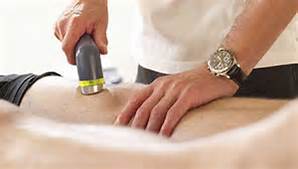
What is the Device with all the Gel? Therapeutic Ultrasound Explained!
By Angeline Petersen
“Are you checking for a foot baby?” That question is not one you may hear very often
and may spark further conversation. Often when presented with the common
therapeutic modality of ultrasound, patient’s in physical therapy question what exactly
it is. They may have heard about one for checking on the health of an unborn baby, but
to be used on an injured part of one’s body!? So, what exactly is this therapeutic
ultrasound Physical Therapist speak of?
Some resources state that the concept of ultrasound was first introduced in the 1880s
with the discovery of emitting sounds waves from an alternating electric field. It wasn’t
until the further evolvement of Physical Medicine in the 1950s when diagnostic
ultrasound was developed. New excitements were developing as research was being
conducted for patients with sciatic pain, sprains, and circulatory disorders. Since then,
numerous studies have been conducted to expand the validity of therapeutic ultrasound
used today.
So, what exactly does this modality do? It has been proven to produce a rise in tissue
temperatures to assist with reduction of muscle guarding, increasing tissue
extensibility, increasing blood flow, and creating a decrease in pain perception.
Depending on the frequency and intensity of the ultrasound treatment, tissues can be
heated. You may have noticed your therapist adjusting such settings on the device,
including MHz (frequency). In short, 3 MHz is used for superficial treatment whereas
1MHz gets to deeper tissues. With rising temperatures in these tissues, blood flow to
the area is increased. This increase may assist with nutrient supply to the area, tissue
repair facilitation, or to rid of inflammation bi-products. It has also been shown to
assist with healing peripheral nerve injuries, tendons, ligaments, muscle, fractures, and
wounds by speeding up the recovery process through protein/collagen synthesis and
cellular proliferation.
You may now be wondering, well why all that gel? Ultrasound must be used with a
coupling medium since its waves are unable to travel through air alone. The goal is to
eliminate the amount of air between the ultrasound head and contact with one’s body.
Most commonly, ultrasound gel may be used. It may also be coupled with medications,
such as dexamethasone or hydrocortisone, known as Phonophoresis. Delivery of
medication through ultrasound is widely used for improving pain reduction. Lotions or
even water may also be used to transmit ultrasound waves effectively. Consistent
movement of the ultrasound head is also critical to prevent burns through “hot spots”
when the device isn’t moving. Smooth, rhythmic motions, are commonly used to allow
for even distribution of the energy.
In summary, ultrasound is a a form of acoustic/sound energy emitting waves with
thermal and non-thermal properties depending on frequency, intensity, and duration. It
has been proven to be an effective means in physical therapy practice for warming
tissues, healing facilitation, and pain management. Interested in learning more or still
rather confused? Feel free to check out the attached websites and articles for a more indepth
understanding of therapeutic ultrasound.
1) Micholvitz, Susan L; Nolan Jr., Thomas P. Modalities for Therapeutic Intervention.
Philadelphia. 2005.
2) Therapeutic Ultrasound: Some Historical Background and Development in Knowledge
of its Effect on Healing. Australian Journal of Physiotherapy. Volume 31, Issue 6. Pages
220-224. 1985.
http://www.sciencedirect.com/science/article/pii/S0004951414606358
3) Overview of Therapeutic Ultrasound Applications and Safety Considerations. J
Ultrasound Medicine. Volume 31, Issue 4. Pages 623-634. 2012.
https://www.ncbi.nlm.nih.gov/pmc/articles/PMC3810427/
4) Ultrasound Therapy. Electrotherapy on the Web. 2015.
http://www.electrotherapy.org/modality/ultrasound-therapy
